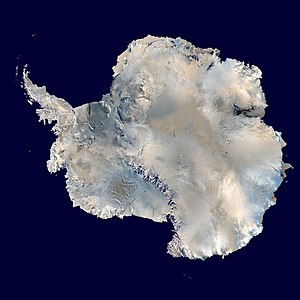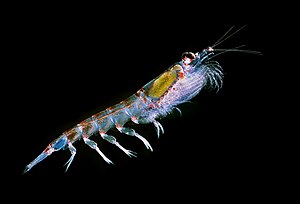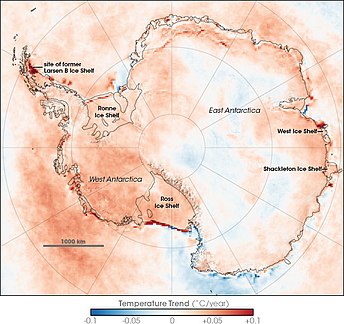Antarctic
The Antarctic (/ænˈtɑːrtɪk/ or /ænˈtɑːrktɪk/, American English also /æntˈɑːrtɪk/ or /æntˈɑːrktɪk/; commonly /æˈnɑːrtɪk/) is a polar region around Earth's South Pole, opposite the Arctic region around the North Pole.


The Antarctic comprises the continent of Antarctica, the Kerguelen Plateau, and other island territories located on the Antarctic Plate or south of the Antarctic Convergence. The Antarctic region includes the ice shelves, waters, and all the island territories in the Southern Ocean situated south of the Antarctic Convergence, a zone approximately 32 to 48 km (20 to 30 mi) wide and varying in latitude seasonally. The region covers some 20 percent of the Southern Hemisphere, of which 5.5 percent (14 million km2) is the surface area of the Antarctica continent itself. All of the land and ice shelves south of 60°S latitude are administered under the Antarctic Treaty System.
Biogeographically, the Antarctic realm is one of eight biogeographic realms on Earth's land surface. Climate change in Antarctica is particularly important because the melting of the Antarctic ice sheet has a high potential to add to the global sea level rise. Further, this melting also disrupts the flow of Southern Ocean overturning circulation, which would have significant effects on the local climate and marine ecosystem functioning.
Geography


As defined by the Antarctic Treaty System, the Antarctic region is everything south of the 60°S latitude. The Treaty area covers Antarctica and the archipelagos of the Balleny Islands, Peter I Island, Scott Island, the South Orkney Islands, and the South Shetland Islands. However, this area does not include the Antarctic Convergence, a transition zone where the cold waters of the Southern Ocean collide with the warmer waters of the north, forming a natural border to the region. Because the Convergence changes seasonally, the Convention for the Conservation of Antarctic Marine Living Resources approximates the Convergence line by joining specified points along parallels of latitude and meridians of longitude. The implementation of the convention is managed through an international commission headquartered in Hobart, Australia, by an efficient system of annual fishing quotas, licenses, and international inspectors on the fishing vessels, as well as satellite surveillance.
The islands situated between 60°S latitude parallel to the south and the Antarctic Convergence to the north and their respective 200-nautical-mile (370 km) exclusive economic zones fall under the national jurisdiction of the countries that possess them: South Georgia and the South Sandwich Islands (United Kingdom), Bouvet Island (Norway), and Heard and McDonald Islands (Australia).
Kerguelen Islands (France; also an EU Overseas territory) are situated in the Antarctic Convergence area, while the Isla Grande de Tierra del Fuego, Falkland Islands, Isla de los Estados, Hornos Island with Cape Horn, Diego Ramírez Islands, Campbell Island, Macquarie Island, Amsterdam and Saint Paul Islands, Crozet Islands, Prince Edward Islands, Gough Island, and Tristan da Cunha group remain north of the Convergence and thus outside the Antarctic region.
Ecology
Antarctica

A variety of animals live in Antarctica for at least some of the year, including:
- Seals
- Penguins
- South Georgia pipits
- Albatrosses
- Antarctic petrels
- Whales
- Fish, such as Antarctic icefish, Antarctic toothfish
- Squid, including the colossal squid
- Antarctic krill

Most of the Antarctica continent is permanently covered by ice and snow, leaving less than 1 percent of the land exposed. There are only two species of flowering plant, Antarctic hair grass and Antarctic pearlwort, but a range of mosses, liverworts, lichens and macrofungi.
Sub-Antarctic Islands
Biodiversity among terrestrial flora and fauna is low on the islands: studies have theorized that the harsh climate was a major contributor towards species richness, but multiple correlations have been found with area, temperature, remoteness of islands, and food chain stability. For example, herbivorous insects are poor in number due to low plant richness, and likewise, indigenous bird numbers are related to insects, which are a major food source.
Conservation

The Antarctic hosts the world's largest protected area comprising 1.07 million km2, the South Georgia and the South Sandwich Islands Marine Protection Area created in 2012. The latter exceeds the surface area of another vast protected territory, the Greenland National Park's 972,000 km2 (375,000 sq mi). (While the Ross Sea Marine Protection Area established in 2016 is still larger at 1.55 million km2, its protection is set to expire in 35 years.) To protect the area, all Antarctic ships over 500 tonnes are subject to mandatory regulations under the Polar Code, adopted by the International Maritime Organization (in force since 1 January 2017).
Climate change

Climate change caused by greenhouse gas emissions from human activities occurs everywhere on Earth, and while Antarctica is less vulnerable to it than any other continent, climate change in Antarctica has already been observed. There has been an average temperature increase of >0.05 °C/decade since 1957 across the continent, although it had been uneven. While West Antarctica warmed by over 0.1 °C/decade from the 1950s to the 2000s and the exposed Antarctic Peninsula has warmed by 3 °C (5.4 °F) since the mid-20th century, the colder and more stable East Antarctica had been experiencing cooling until the 2000s. Around Antarctica, the Southern Ocean has absorbed more heat than any other ocean, with particularly strong warming at depths below 2,000 m (6,600 ft): 1230 and around the West Antarctic, which has warmed by 1 °C (1.8 °F) since 1955.
The warming of Antarctica's territorial waters has caused the weakening or outright collapse of ice shelves, which float just offshore of glaciers and stabilize them. Many coastal glaciers have been losing mass and retreating, which causes net annual ice loss across Antarctica,: 1264 even as the East Antarctic ice sheet continues to gain ice inland. By 2100, net ice loss from Antarctica alone is expected to add about 11 cm (5 in) to global sea level rise. However, marine ice sheet instability may cause West Antarctica to contribute tens of centimeters more if it is triggered before 2100.: 1270 With higher warming instability would be much more likely, and could double overall 21st century sea level rise.
The fresh meltwater from the ice, 1100-1500 billion tons (GT) per year, dilutes the saline Antarctic bottom water, thus weakening the lower cell of the Southern Ocean overturning circulation.: 1240 Some research tentatively suggests a full collapse of the circulation may occur between 1.7 °C (3.1 °F) and 3 °C (5.4 °F) of global warming, although the full effects are expected to unfold over multiple centuries. They include less precipitation in the Southern Hemisphere but more in the Northern Hemisphere, and an eventual decline of fisheries in the Southern Ocean with a potential collapse of certain marine ecosystems. Furthermore, while many Antarctic species remain undiscovered, there are already documented increases in flora and large fauna such as penguins are already seen struggling to retain suitable habitat. On ice-free land, permafrost thaws, releasing not only greenhouse gases, but also formerly frozen pollution.
The West Antarctic ice sheet is likely to melt completely,unless temperatures are reduced by 2 °C (3.6 °F) below the levels of the year 2020. The loss of this ice sheet would take between 2,000 and 13,000 years, although several centuries of high emissions could shorten this timeframe to 500 years. A sea-level rise of 3.3 m (10 ft 10 in) would occur if the ice sheet collapses leaving ice caps on the mountains and 4.3 m (14 ft 1 in) if those ice caps also melt. Isostatic rebound may contribute an additional 1 m (3 ft 3 in) to global sea levels over another 1,000 years. In contrast, the East Antarctic ice sheet is far more stable and may only cause a sea-level rise of 0.5 m (1 ft 8 in) - 0.9 m (2 ft 11 in) from the current level of warming, a small fraction of the 53.3 m (175 ft) contained in the full ice sheet. With a global warming of around 3 °C (5.4 °F), vulnerable areas like the Wilkes Basin and Aurora Basin may collapse over a period of around 2,000 years, potentially adding up to 6.4 m (21 ft 0 in) to sea levels. The complete melting and disappearance of the East Antarctic ice sheet would require at least 10,000 years, and it would only occur if global warming reaches 5 °C (9.0 °F) to 10 °C (18 °F).Society

People
The first recorded sighting of Antarctica is credited to the Spaniard Gabriel de Castilla, who reported seeing distant southern snow-capped mountains in 1603. The first Antarctic land discovered was the island of South Georgia, visited by the English merchant Anthony de la Roché in 1675. Although myths and speculation about a Terra Australis ("Southern Land") date back to antiquity, the first confirmed sighting of the continent of Antarctica is commonly accepted to have occurred in 1820 by the Russian expedition of Fabian Gottlieb von Bellingshausen and Mikhail Lazarev on Vostok and Mirny.
The Australian James Kerguelen Robinson (1859–1914) was the first human born in the Antarctic, on board the sealing ship Offley in the Gulf of Morbihan (Royal Sound then), Kerguelen Island on 11 March 1859. The first human born and raised on an Antarctic island was Solveig Gunbjørg Jacobsen born on 8 October 1913 in Grytviken, South Georgia.

Emilio Marcos Palma (born 7 January 1978) is an Argentine man who was the first documented person born on the continent of Antarctica at the Esperanza Base. His father, Captain Jorge Palma, was head of the Argentine Army detachment at the base. While ten people have been born in Antarctica since, Palma's birthplace remains the southernmost. In late 1977, Silvia Morella de Palma, who was then seven months pregnant, was airlifted to Esperanza Base, in order to complete her pregnancy in the base. The airlift was a part of the Argentine solutions to the sovereignty dispute over territory in Antarctica. Emilio was automatically granted Argentine citizenship by the government since his parents were both Argentine citizens, and he was born in the claimed Argentine Antarctica. Palma can be considered to be the first native Antarctican.

The Antarctic region had no indigenous population when first discovered, and its present inhabitants comprise a few thousand transient scientific and other personnel working on tours of duty at the several dozen research stations maintained by various countries. However, the region is visited by more than 40,000 tourists annually, the most popular destinations being the Antarctic Peninsula area (especially the South Shetland Islands) and South Georgia Island.
In December 2009, the growth of tourism, with consequences for both the ecology and the safety of the travellers in its great and remote wilderness, was noted at a conference in New Zealand by experts from signatories to the Antarctic Treaty. The definitive results of the conference were presented at the Antarctic Treaty states' meeting in Uruguay in May 2010.
Time zones
Because Antarctica surrounds the South Pole, it is theoretically located in all time zones. For practical purposes, time zones are usually based on territorial claims or the time zone of a station's owner country or supply base.
List of offshore islands
North of 60°S latitude

South of 60°S latitude
See also
Notes
References
This article uses material from the Wikipedia English article Antarctic, which is released under the Creative Commons Attribution-ShareAlike 3.0 license ("CC BY-SA 3.0"); additional terms may apply (view authors). Content is available under CC BY-SA 4.0 unless otherwise noted. Images, videos and audio are available under their respective licenses.
®Wikipedia is a registered trademark of the Wiki Foundation, Inc. Wiki English (DUHOCTRUNGQUOC.VN) is an independent company and has no affiliation with Wiki Foundation.








